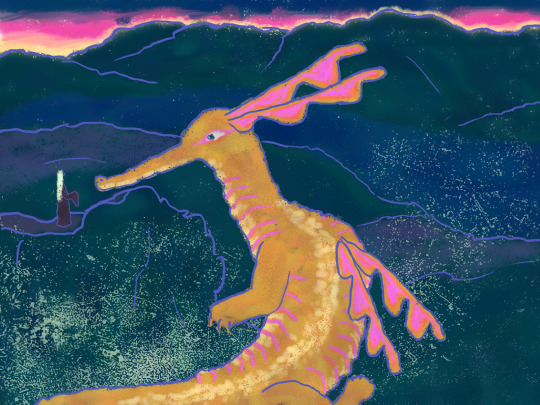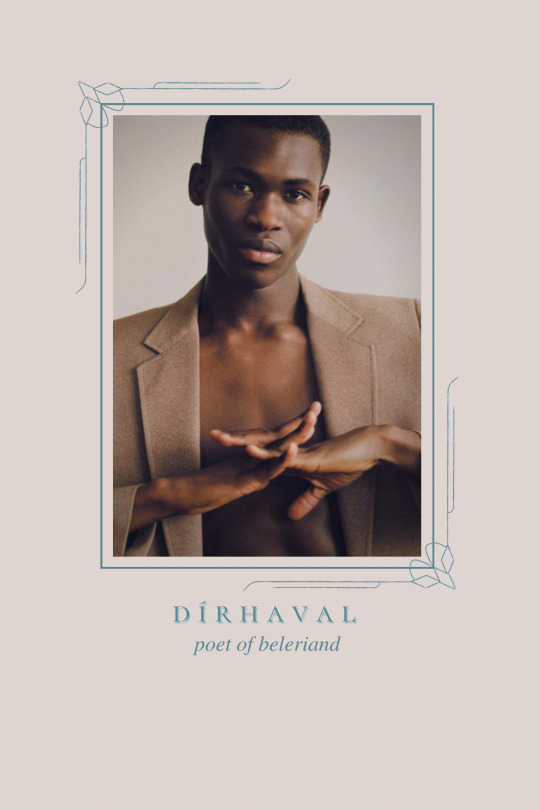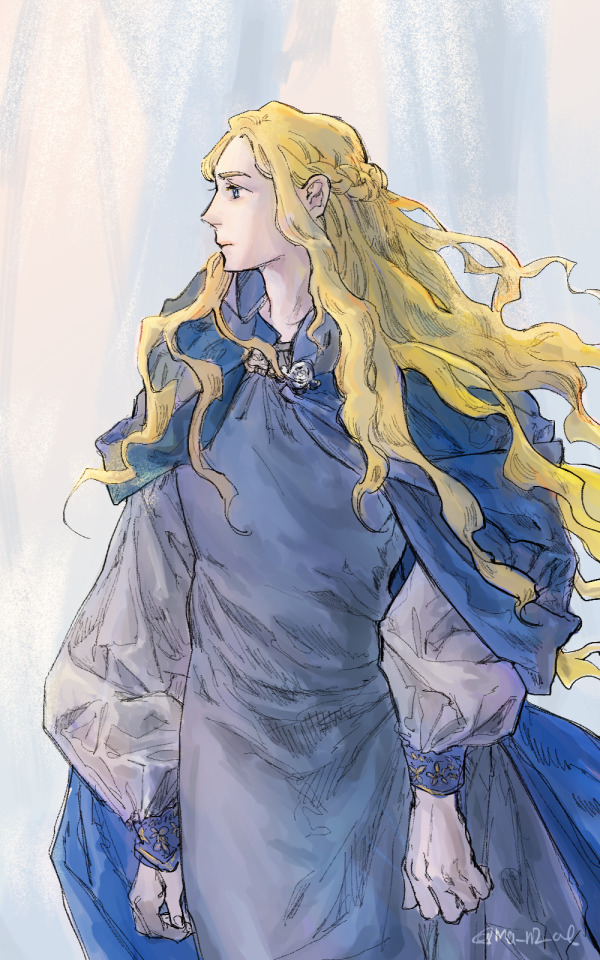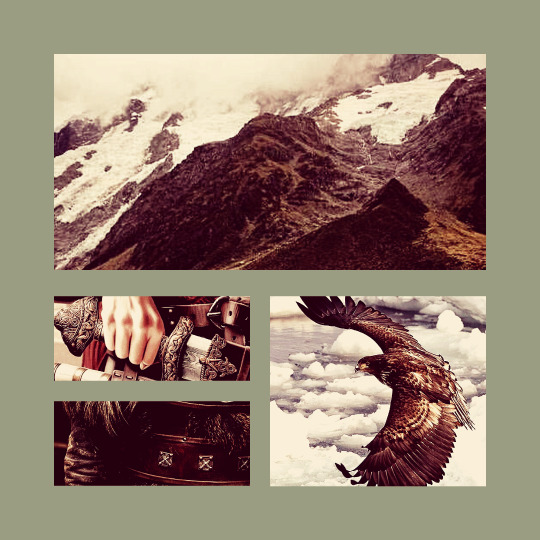#Narn i Chîn Húrin
Text

Glaurung and Nienor on top of Amon Ethir
#tolkien#coh#the children of hurin#narn i chin hurin#Narn i Chîn Húrin#tcoh#the silm#nienor#glaurung#the silmarillion#silm art#my art#yes i'm not 100% sure what time of the day it's actually set at. but I wanted to draw a sunset
26 notes
·
View notes
Photo

The meeting of Beleg and Túrin
In 2016, I made some inks and painted this Codex-Manesse-inspired thing. If I scanned it back then (I’m certain I did!), the scan is lost - and some of the colours have faded considerably
#tolkien#Narn i Chîn Húrin#Beleg Cúthalion#Túrin Turambar#Gethron#Grithnir#and one of the dogs ;)#since I can't seem to make anything new ...#and this was fun#i have this vague idea for an illuminated manuscript of the lay of the children of húrin#but not in this style!#in the style of the utrecht psalter my one true love
225 notes
·
View notes
Note
Silm anon from a few weeks ago back. I thought you’d find this funny. But anyway before I finished the Silm, I got overeager and went to the library to check out more Tolkien books. The only one they had was Children of Hurin. ‘This is great,’ I thought to myself, ‘Hurin! His children! Why that must mean the Stewards! I love the stewards!’
Because, you see, the thing is at that time not only had I not finished the Silm, I hadn’t gotten to Turins chapter yet either 😐 I did very soon after I brought the book home and very very quickly realized my mistake lol
Hi!
I read this as I was going to sleep and burst out laughing once I saw where it was going. A natural mistake but, ah, very different stories, to be sure!
#anon replies#respuestas#legendarium blogging#a thing of beauty is a joy forever#narn i chîn húrin#húrinionath
9 notes
·
View notes
Text




"[Pengolodh] was one of the survivors of the destruction of Gondolin, from which he rescued a few ancient writings, and some of his own copies, compilations, and commentaries. It is due to this, and to his prodigious memory, that much of the knowledge of the Elder Days was preserved."
- J.R.R. Tolkien, The History of Middle-earth: The War of the Jewels, "Appendix D: Quendi and Eldar"
"...the Narn i Hîn Húrin was the work of a Mannish poet, Dírhavel, who lived at the Havens of Sirion in the days of Eärendil, and there gathered all the tidings that he could of the House of Hador, whether among Men or Elves, remnants and fugitives of Dor-lómin, of Nargothrond, of Gondolin, or of Doriath. [...] this lay, longest of all the lays of Beleriand, was all that he ever made, but it was prized by the Eldar, for Dírhavel used the Grey-elven tongue, in which he had great skill."
- J.R.R. Tolkien, Unfinished Tales, "The Tale of the Children of Húrin"
@tolkienofcolourweek || day 4: music + artwork || pengolodh & dírhaval, chroniclers of lore
[ID: an edit comprised of 4 graphics. Each shows a small rectangular image framed in teal on a greyish-beige background. There is teal text underneath each image.
1: Chloe Magno, a filipino-american model with tan skin and short black hair. She is wearing a grey garment, partially fallen off her shoulders, and is looking at the viewer pensively. The text reads "pengolodh" and "loremaster of the noldor" / 2: Bound scrolls written in various scripts. Text reads "writer of the grey annals" / 3: Stringed instruments from a variety of cultures hanging on a wall. Text reads "composer of the narn i chîn húrin" / 4: Ismael Savane, an ivorian model with dark skin and close-cropped hair. He is wearing a light brown jacket and has his hands interlaced in front of him as he looks directly at the viewer with a thoughtful, serious expression /End ID]
#tocweek2023#brought to you by me#edits with the wild hunt#the professor's world#elves elves elves#pengolodh#dírhaval#the silmarillion#mepoc#described#fc: chloe magno#fc: ismael savane#graphics#posters#silmedit#tolkienedit#elvensource#tolkiensource#oneringnet
54 notes
·
View notes
Note
what's "the Narn"? I see that used a lot, but I don't understand it
The same thing as The Children of Hurin! "Narn i Chîn Húrin" is Sindarin for "Tale of the Children of Húrin" and it's how that story is known in Middle-earth, like "Beren and Luthien" can be called "Lay of Leithian" or "The Hobbit" can be called "There and back again."
Not everybody uses it this way, but personally, usually when I say Children of Hurin (or just CoH) I mean "The 2007 book" while when I say "the Narn" I mean the story itself in all its many versions
15 notes
·
View notes
Note
I agree with your most recent Narn I Chîn Húrin post and also I’d say there are moments of bravery and stubbornness that do actually impede Morgoth (but are ultimately futile) which of course makes everything even more painful
Morwen’s courage against the invaders to Hithlum to the point that they are terrified of her and she’s able to get Túrin out is the first example that comes to mind because I’m literally obsessed with this part of the book but there are other examples too
What’s so interesting I think is this is the evils of Melkor working against him; the human instinct to ostracize certain people, to scapegoat and fear the other is clearly what Melkor loves to hone and exacerbate. And in this instance it at least for a moment works against him.
And ultimately it doesn’t matter because Morwen and her children aren’t killed at the hands of Melkor’s servants. Túrin and Niënor die by their own hands.
I have already rambled about this stuff a lot so I’ll end here for now but anyways it’s a great post and made me feel a lot
-@outofangband
Oh, there absolutely are! The one that you mention with Morwen is one, and Túrin killing Glaurung is one, and 17-year-old Túrin insisting on going to the front lines to fight is one - and Aerin risking herself to protect and help Morwen and Sador and others is a more subtle one. And I love your insight about the xenophobia that Morgoth pushes working against him to keep Morwen safe! Now I want to think about if there are other cases like that in the Silm. (There are in LOTR, of course - most iconically, Sauron’s decision to make the desire for the Ring irresistably powerful being what leads to its destruction via Gollum.)
I’ve had a lot of opinions about the intersections/combinations/relative importance of the curse and of Túrin’s poor decisions, but it didn’t click to me until now that the fundamental nature and evil of the curse is that it’s aimed at weaponizing the very virtues that Húrin is using against Morgoth. Potentially even with the goal of making Húrin decide those virtues aren’t worth it and give in - but Morgoth fails at that. He holds to the value of those virtues to the end: his euology of “She was not conquered” for Morwen (one of my absolute favourite lines!) is a tribute to them.
10 notes
·
View notes
Text

For 28 years, Húrin watched the curse destroy his children. His daughter, Nienor, was born shortly after his capture and was trapped in the doom of Túrin. Their actions also led to the destruction of Nargothrond, one of the last kingdoms of the Noldor. Now only Gondolin remained.
In 499, after the death of his children, Morgoth freed Húrin. The broken man first returned to Dor-lómin, which was now ruled by Easterlings loyal to Morgoth. Finding none of his kin, he traveled with outlaws to the mountains of Echoriath, searching for the entrance to Gondolin. At first Turgon refused him, but later recanted and sent Eagles to bring him to Gondolin. Húrin had already left for the Forest of Brethil, but Morgoth's curse had already ensnared Gondolin, for the Dark Lord's spies now knew the location of the Hidden Kingdom.
In the Forest of Brethil he found the graves of his children. His wife, Morwen, was there and she died shortly after. After burying his wife, Húrin went to the settlement of Ephel Brandir, the home of the People of Haleth, with whom Túrin lived the last years of his life. Angry and grieving, he turned the People of Haleth against one another and ruined Ephel Brandir.
Húrin continued on to the ruins of Nargothrond, where he found the Petty-dwarf Mîm. The petty-dwarf had betrayed Túrin years ago and in revenge Húrin slaughtered him. Mîm had claimed the treasure of Nargothrond, but Húrin recovered the Nauglamír and took it to Doriath, the last great elvish kingdom.
Húrin was allowed to enter Menegroth, the capital of Doriath, where in anger he threw the Nauglamír before King Thingol and 'thanked' him for aiding his son. Thingol's wife, Melian, finally pierced through Húrin's madness and grief, and shamed by his actions, he picked up the Nauglamír to give to the king as a gift and memorial, then he left Menegroth a broken man. Since Húrin left the Nauglamír, the curse of Morgoth, the Oath of Fëanor, and the Doom of Mandos would later contribute to the destruction of Doriath as well.
Around F.A. 500, Húrin reached the Great Sea and in despair drowned himself. His life, and the lives of his children would become the Narn i Chîn Húrin.
Art by Ted #Nasmith
6 notes
·
View notes
Photo

Just a few sketches inspired by Tolkien's Narn i Chîn Húrin (Tale of the Children of Húrin). Of especial interest or focus is Glaurung the dragon: I tried to mix the style of the dragons Tolkien would draw with something a little more fearsome.
0 notes
Text

Niënor Níniel
Daughter of Húrin Thalion and Morwen Eledhwen
twt @Ma_n2_al
do not repost, reupload or use my work :)
338 notes
·
View notes
Text
Nellas (ft. Beleg’s hands) 🌿🍃🏹


I can’t find my copy of CoH, to my great displeasure, but I’m sure it says Beleg “led [Nellas] by the hand.” This is the moment she says, if I remember correctly, “Lord, I was sitting in a tree.” I decided to draw her because of that; it’s my second favourite Tolkien quote, right after Legolas’ “Ah! The green smell. It is better than much sleep. Let us run!”
#my art#my drawings#November 2021#Everyone’s favourite Tolkien quote seems to be beautiful or at least analyse-able#but despite having studied literature those genuinely are mine#anyway I also decided to draw Nellas because I relate to her#mostly because I also am a tree-hugger#and my friends forget me too#That might have subconsciously/unintentionally guided this. Everyone I’ve dared show her to said she looks like me.#my perfectionism was through the roof recently and I feel when I have no confidence it really shows in my work but ¡I GOT IT DONE!#Nellas#Beleg#Children of Húrin#Narn i Chîn Húrin#Silmarillion
92 notes
·
View notes
Text




NARN I CHÎN HÚRIN [1/?] - Húrin Thalion
#hurin thalion#hurin#house of hador#narn i chîn húrin#the children of hurin#coh#narn#tolkien#silmarillion#silm#silmedit#tolkienedit#cohedit#my edit#not my pictures#look this man is pretty close to how I imagine a younger hurin#also how do you like the new-ish edit style?#and also: yes this is going to ve a series but i have no clue how many characters I'm going to include#either huor or morwen is next
43 notes
·
View notes
Link
'Nine years Túrin dwelt in the halls of Menegroth. His heart and thought turned ever to his own kin, and at times he had tidings of them for his comfort. For Thingol sent messengers to Morwen as often as he might, and she sent back words for her son; thus Túrin heard that his sister Nienor grew in beauty, a flower in the grey North, and that Morwen's plight was eased.' From the artist's notes, excerpted from the Unfinished Tales
#lalaith#narn i chîn húrin#turin turambar#unfinished tales#children of hurin#silmarillion#tolkien#jrr tolkien#cosmere#sazed#mistborn#mistborn fanart#cosmere art#queue to you too#old quizup posts
6 notes
·
View notes
Text
(from the appendix of Lost Tales II)

I know this is lenition and Tuor’s father is called Peleg in LT, BUT:
AU: Beleg the father-less takes his found family trope too literally and adopts another random human child he finds in the woods
#tolkien#Narn i Chîn Húrin#plus#Tuor and the Fall of Gondolin#sorry for not being around#I'd like to draw something but I'm 100% uninspired
13 notes
·
View notes
Text
I like Túrin, but I particularly love that he’s drawn to Finduilas because her Vanya-derived golden perfection reminds him of Hadorian women.
In general, where there’s a resemblance, it’s mortals (like Túrin himself!) who are reminiscent of the fabulousness of Elves, and I really enjoy it going the other way around here.
#it doesn't seem to arise out of hostility to elves either#it's just that hadorian women are his ideal#and vanyar/part-vanyar can approach it but... hadorians are the real deal for him#<3#anghraine babbles#túrin turambar#narn i chîn húrin#legendarium blogging
49 notes
·
View notes
Photo

[ x ]
#the silmarillion#the children of hurin#narn i chîn húrin#text post meme#turin turambar#or whichever of his like twenty other names you want
201 notes
·
View notes
Text
the entire narn i chîn húrin is just like. chapter title: “Túrin Goes to A New Place” and then the very next chapter is titled “The Fall of The Place Túrin Just Went To” and it just repeats like that over and over until he’s been to and caused the fall of every single thing in beleriand for satan’s personal entertainment
#and satan has his dad sitting in a chair like a clockwork orange watching his son fuck up until he and everyone he knows is dead#me picking up this book: well i know jirt and i know my celtic legends. ive read the children of liir i know how this goes#lotr#q#alternatively: narn i chîn húrin is like if the book of job was entirely satan fucking some guys up and god just wasnt even in it
15 notes
·
View notes